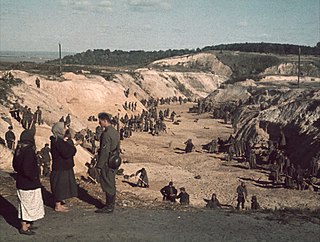
Babi Yar or Babyn Yar is a ravine in the Ukrainian capital Kyiv and a site of massacres carried out by Nazi Germany's forces during its campaign against the Soviet Union in World War II. The first and best documented of the massacres took place on 29–30 September 1941, in which some 33,771 Jews were murdered. Other victims of massacres at the site included Soviet prisoners of war, communists and Romani people. It is estimated that a total of between 100,000 and 150,000 people were murdered at Babi Yar during the German occupation.
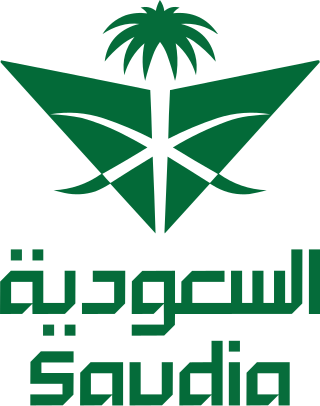
Saudia, formerly known as Saudi Arabian Airlines, is the flag carrier of Saudi Arabia, based in Jeddah. The airline's main hubs are the King Abdulaziz International Airport in Jeddah and the King Khalid International Airport in Riyadh, the latter of which it plans to move out of by 2030.
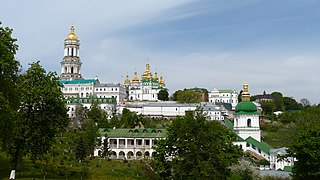
Kyiv is the capital and most populous city of Ukraine. It is in north-central Ukraine along the Dnieper River. As of 1 January 2022, its population was 2,952,301, making Kyiv the seventh-most populous city in Europe. Kyiv is an important industrial, scientific, educational, and cultural center in Eastern Europe. It is home to many high-tech industries, higher education institutions, and historical landmarks. The city has an extensive system of public transport and infrastructure, including the Kyiv Metro.

Dnipro is Ukraine's fourth-largest city, with about one million inhabitants. It is located in the eastern part of Ukraine, 391 km (243 mi) southeast of the Ukrainian capital Kyiv on the Dnipro River, after which its name is derived. Dnipro is the administrative centre of Dnipropetrovsk Oblast. It hosts the administration of Dnipro urban hromada. Dnipro has a population of 968,502.
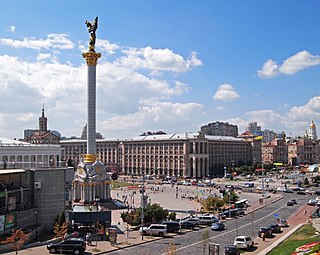
Maidan Nezalezhnosti (Ukrainian: Майдан Незалежності, IPA:[mɐjˈdɑnnezɐˈɫɛʒnosti] or Independence Square is the central town square of Kyiv, the capital city of Ukraine. One of the city's main squares, it is located on Khreshchatyk Street in the Shevchenko Raion. The square contains the iconic Independence Monument.
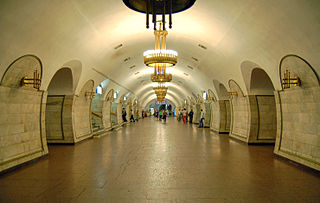
Ploshcha Ukrainskykh Heroiv is a station on Kyiv Metro's Obolonsko–Teremkivska Line. Until May 2023 it was named Ploshcha Lva Tolstoho. The station was opened on 19 December 1981, and was named after the writer Leo Tolstoy. Tolstoy had visited the city only once. The station was designed by N.A. Levchuk and V.B. Zhezheryn.

The Shevchenkivskyi District is an urban district of the city of Kyiv, the capital of Ukraine. It was originally established on 4 April 1937, although in 2001 its area was increased following an annexation of the former Radianskyi and Starokyivskyi districts.

Zvirynetska is a station of Kyiv Metro's Syretsko-Pecherska Line. It is situated between Pecherska and Vydubychi stations. This station was opened on 30 December 1991. Until May 2023 the station was named Druzhby Narodiv or Friendship of Peoples

Russia–Saudi Arabia relations are the bilateral relations between the Russian Federation and the Kingdom of Saudi Arabia. The two countries are referred to as the two petroleum superpowers and account for about a quarter of the world's crude oil production between them.
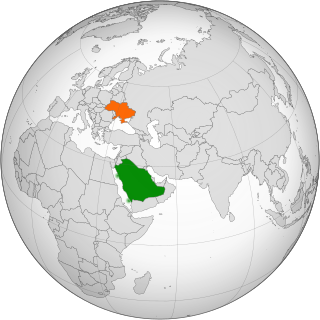
Saudi Arabia–Ukraine relations are foreign relations between Saudi Arabia and Ukraine. Saudi Arabia recognized Ukraine’s independence in 1992. Diplomatic relations between both countries were established in April 1993. Saudi Arabia has an embassy in Kyiv. Ukraine has an embassy in Riyadh and an honorary consulate in Jeddah.
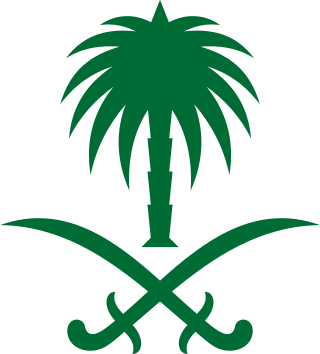
The Saudi Council of Ministers is the cabinet of the Kingdom of Saudi Arabia. It is led by the King. The council consists of the king, the Crown Prince, and cabinet ministers. The Crown Prince is also the Prime minister and Chairman of the Council of Ministers. Since 2015, there are 23 ministers with portfolio and seven ministers of state, two of whom have special responsibilities. All members of the council are appointed by royal decree.

Batyieva Hora is a former village, and now a neighborhood in the Solomianskyi District of Kyiv, the capital of Ukraine. It is located on the right bank of the Dnieper, on the side of the hill above the river Lybid. Burial grounds of Zarubintsy culture dated in the 2nd-4th century AD were discovered in Batyieva Hora.

The Royal Embassy of Saudi Arabia in Washington, D.C. is the Kingdom of Saudi Arabia's main and largest diplomatic mission to the United States. It is located at 601 New Hampshire Avenue NW/Jamal Khashoggi Way, Washington, D.C., in the Foggy Bottom neighborhood, near the Watergate complex, and Kennedy Center.

The Embassy of the United States of America in Kyiv is the diplomatic mission of the United States to Ukraine.
The following is a timeline of the history of the city of Kyiv, Ukraine.
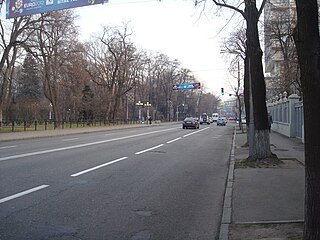
Mykhailo Hrushevskyi Street or simply Hrushevskyi Street is a street in central Kyiv, the capital of Ukraine.
Derussification in Ukraine is a process of removing Russian influence from the post-Soviet country of Ukraine. This derussification started after the collapse of the Soviet Union in 1991 and intensified with the demolition of monuments to Lenin during Euromaidan in 2014 and the further systemic process of decommunization in Ukraine. The Russo-Ukrainian War gave a strong impetus to the process. Along with decommunization, derussification has been described as one of the components of a larger process of decolonization in Ukraine.

Roman Ratushny was a Ukrainian journalist and public activist. Ratushnyi was one of the first participants in the 2014 "Revolution of Dignity". In 2018, he founded an initiative that fights against construction in the green zone of Protasiv Yar in Kyiv. When the Russian invasion of Ukraine began in 2022, Ratushnyi joined the Armed Forces of Ukraine. He died in Sulyhivka, a village near Izium, in June 2022.
















